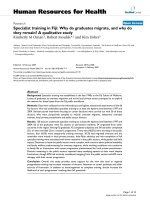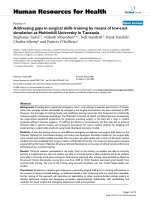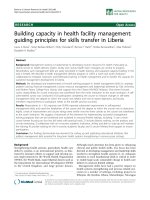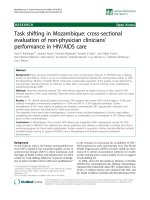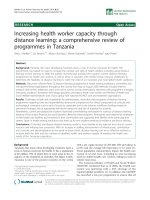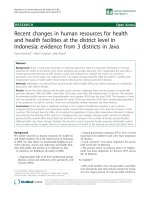Báo cáo sinh học: " Codon usage in vertebrates is associated with a low risk of acquiring nonsense mutations" doc
Bạn đang xem bản rút gọn của tài liệu. Xem và tải ngay bản đầy đủ của tài liệu tại đây (2.56 MB, 7 trang )
Codon usage in vertebrates is associated with a
low risk of acquiring nonsense mutations
Schmid and Flegel
Schmid and Flegel Journal of Translational Medicine 2011, 9:87
(8 June 2011)
RESEARCH Open Access
Codon usage in vertebrates is associated with a
low risk of acquiring nonsense mutations
Pirmin Schmid and Willy A Flegel
*
Abstract
Background: Codon usage in genomes is biased towards specific subsets of codons. Codon usage bias affects
translational speed and accuracy, and it is associated with the tRNA levels and the GC content of the genome.
Spontaneous mutations drive genomes to a low GC content. Active cellular processes are needed to maintain a
high GC content, which influences the codon usage of a species. Loss-of-function mutations, such as nonsense
mutations, are the mole cular basis of many recessive alleles, which can greatly affect the genome of an organism
and are the cause of many genetic diseases in humans.
Methods: We developed an event based model to calculate the risk of acquiring nonsense mutations in coding
sequences. Complete coding sequences and genomes of 40 eukaryotes were analyzed for GC and CpG content,
codon usage, and the associated risk of acquiring nonsense mutations. We included one species per genus for all
eukaryotes with available reference sequence.
Results: We discovered that the codon usage bias detected in genomes of high GC content decreases the risk of
acquiring nonsense mutations (Pearson’s r = -0.95; P < 0.0001). In the genomes of all examined vertebrates,
including humans, this risk was lower than expected (0.93 ± 0.02; mean ± SD) and lower than the risk in genomes
of non-vertebrates (1.02 ± 0.13; P = 0.019).
Conclusions: While the maintenance of a high GC content is energetically costly, it is associated with a codon
usage bias harboring a low risk of acquiring nonsense mutations. The reduced exposure to this risk may contribute
to the fitness of vertebrates.
Background
Codon usage bias in genomes is relevant for organisms.
It influences the translation speed and thus gene expres-
sion [1]. Artificially deoptimized codon usage can
decrease gene expression and create an attenuated viral
virulence that m ay be used for vaccine produc tion [2].
HIV-1 modifies the tRNA pool of the infected cells to
increase translation efficiency of its own genes [3].
Initial studies on codon usage bias were based on few
genes in single species: lists of the c odon usage [4],
determination of the number of codons used in genes
[5], and models, such as the codon adaptation index
(CAI). The CAI compared the codon usage of each gene
with an “optimal” codon usage, which is inferred from
high-expression gene sets [6]. Whole genome sequen-
cing data and newer algorithms have allowed
researchers to overcome previous limitations, study
more genes, and classify genes in more detailed cate-
gories [7]. Codon usage bias is associated with tRNA
concentration [8] and also the GC content of genomes
[9-12].
Loss-of-function mutations, such as nonsense muta-
tions, are the molecular basis of many recessive disor-
ders, conditions that stem from non-functional gene
products or, in case of null alleles, a lack of gene pro-
ducts. Nonsense mutations cause the premature stop of
translation with shortened and often non-functional
proteins. As part o f the RNA surveillance, nonsense-
mediated decay efficiently eliminates any mRNA that
harbors nonsense mutations [13]. For example, loss of
tumor suppressor genes have been recognized as a key
mechanism in many cancers [14]. Retaining one func-
tional allele of critical genes is essential for survival.
Still, null alleles are common: the blood group O is a
widely recognized and clinically relevant example [15].
* Correspondence:
National Institutes of Health, Clinical Center, Bethesda, MD, USA
Schmid and Flegel Journal of Translational Medicine 2011, 9:87
/>© 2011 Schmid and Flegel; licensee BioMed Central Ltd. This is an Open Access article distributed under the terms of the Creative
Commons Attribution License ( which permits unrestricted use , distri bution, and
reprodu ction in any medium, provided the original wor k is properly cited.
Rare null phenotypes of blood gro ups have been used to
identify null alleles in large populations using routine
clinical methods [16,17].
We wondered if the codon usage bias in organisms is
associated with a propensity of acquiring nonsense
mutations. The consequence of a single n ucleotide sub-
stitution, like a syno nymous, missense or nonsense
mutation, is intrinsic in the genetic code. Based on this
association, we developed a method to calculate the risk
of acquiring nonsense mutations in coding sequences
(CDS) relative to an unbiased random codon usage. We
applied this method to investigate the codon usage in
the whole genome sequences of 40 eukaryotic species.
Methods
Risk of acquiring nonsense mutations
We used an event based model to estimate the risk of
acquiringnonsensemutationsbyasinglenucleotide
substitution. A score ω of{0,1,2}wasdeterminedfor
each of the 61 non-termination codons based on the
number of possible single nucleotide substitutions that
lead to a stop codon (Figure 1). For this study, the
count c
xxx
and risk score ω
xxx
of each codon xxx, with x
of {A, C, G, T}, was used to determine a risk score Ω
se-
quence
for all coding sequences (CDS) of a species:
sequence
=
xxx
c
xxx
· ω
xx
x
(1)
To account for the different proteins encoded by t he
genomes of different species, Ω
random
was calculated for
comparison assuming an unbiased usage of codons,
which was deduced by the number of amino acids aa
(xxx)
encoded by codon xx x and synonymous codons,
and the number of codons encoding this amino acid n
sy-
nonymous,(xxx)
:
random
=
xxx
aa
(xxx)
n
synonymous,(xxx)
· ω
xx
x
(2)
Based on these equations, the parameter “stop risk
factor” F was calculated for the entire set of CDS in the
Figure 1 Genetic code and risk of acq uiring nonsense mutations. The codons of the standard genetic code are listed along with the 20
amino acids and the three stop codons. A risk score ω is shown as ω = 0 (yellow), ω = 1 (orange), and ω = 2 (red). The list is sorted according
to the mean risk of the codons encoding a specific amino acid.
Schmid and Flegel Journal of Translational Medicine 2011, 9:87
/>Page 2 of 6
species’ genome:
F =
sequence
random
(3)
This F defines the risk of acquiring nonsense muta-
tions for each species relative to the risk with an
unbiased codon usage. With the intention to compare
the risk of acquiring nonsense mutations among v arious
species, we concluded that a random codon usage was
the most neutral denominator. These calculations
allowed a novel approach to study codon usage bias in
whole genomes.
GC and CpG contents
GC content was calculated as C+G per total nucleotide
count, and CpG content as number of CpG dinucleo-
tides per total nucleotide count. The CpG content of
genomes was comparable to the results of a recent in
silico study [18] for P an troglodytes, Mus musculus, Rat-
tusnorvegicus,Bostaurus,Canislupusfamiliaris,and
Danio rerio. Our calculated figures for CpG content
match the data obtained by the original in vitro method
[19,20].
The expected GC content for the CDS was calculated
with the number of codons n in the CDS and GC con-
tent
xxx
denoting the GC content of the codon xxx:
e
xpected GC content =
1
n
·
xxx
aa
(xxx)
n
synonymous,(xxx)
· GC content
xx
x
(4)
The expected CpG content was calculated as
described [21]:
e
xpected CpG content =
GC content
2
2
(5)
Database and species selection
The NCBI table Eukaryotic Genome Sequencing Pro-
jects (March 30 , 201 0) [22] was used to include all spe-
cies with a genome status “complete” or “ assembly” and
an available Ref Seq. We restricted analysis to one spe-
cies per genus (Additional file 1, Figure S1 and Table
S1). Sequence data repres ent NCBI RefSeq database
release 40 (March 2010) for 39 species plus GRCh37.p2
(August 2010) for the human genome [23].
Software
We developed a script driven software package, which
parsed the genomic data (FASTA for nucleotide
sequences and GenBank flatfile for meta-data including
CDS definitions) and calculated the parameters defined
in this study, in particular the stop risk factor F.In
total, 145 GB of data were analyzed.
Algorithms
(i) Data selection. The whole genomes of the species
were scanned by the software. Non-standard code
sequences, in particular mitochondrial sequences, were
excluded from analysis. (ii) Analysis of the whole gen-
omes. Nucleotide count, GC content and CpG content
were calculated for the genomic sequences of the a na-
lyzed species. Non-ACGT nucleotides (3.8%) were
excluded. (iii) Analysis of CDS. CD S were used as
defined in the RefSeq [23]. CDS were excluded that
were incomplete at their 5’ or 3’ end (4.2%) or contained
errors (non-triplets 1.3%, no stop codon 0. 5%, non-
ACGT nucleotides 0.4%). If C DS were associated with
an identical geneID, like in splice variants, the longest
CDS was used and the alternate sequences (multiples,
13.0%) excluded (Additional file 1, Table S2). F,GC
content, Cp G content and relative codon collection
usage were calculated for the CDS.
Statistical analysis
Results are shown as mean and standard deviation
(mean ± SD) or 95% confidence interval (CI) based on
the normal distribution, which w as tested by D’ Agos-
tino-Pearson. We evaluated correlations by Pearson’ s
correlation coefficient r andcomparedtheGCcontent
ofCDSandgenomesamongspeciesgroupsbytwo-
sided Mann-Whitney U test. P < 0.05 was considered
statistically significant. Statistical analysis was done with
MedCalc (MedCalc Software, Mariakerke, Belgium).
Results and Disc ussion
We analyzed the whole genomes and CDS of 40 eukar-
yotes (Additional file 1, Tables S1 to S4) to determine
the stop risk factor F using the propensity of each
codon to acquire a nonsense mutation (Figure 1).
Risk F of acquiring nonsense mutations
F deviated from the risk of an unbiase d codon usage,
which is represented by F = 1.0 (Figure 2). All 10 verte-
brates had an F < 1.0 and were clustered (0.93 ± 0.02,
range 0.91 - 0.96), while the F of all 30 non-vertebrates
was higher and ranged widely (1.02 ± 0.13, range 0.82 -
1.37; P = 0.019). Fifteen non-vertebrate species had an F
> 1.0.
F and GC content
F correlated strongly and inversel y with the GC content
of the CDS (Figure 3; Pearson’s r = -0.95; P < 0.0001).
The inverse correlation of F and GC content is
explained by the nucleotide composition of the three
stop codons: TAA, TAG, and TGA. The GC content of
these three codons is only
2
/
9
, while the expected mean
is
1
/
2
. Codons with a high GC content have a nucleotide
composition that greatly differs from those of stop
Schmid and Flegel Journal of Translational Medicine 2011, 9:87
/>Page 3 of 6
codons. In comparison, codons with a low GC content
are more similar to the stop codons. Hence, codons
with a high GC content have on average a lower risk of
acquiring a nonsense mutation (Additional file 1, Table
S5).
The GC content of codons correlates with the overall
GC content of the genomes in many species [9,12,24].
This was confirmed by our data (Additional file 1,
Tables S3 and S4). Genes and gene families occur more
frequently in genome regions with a high GC content
[25,26]. Both observations have been attributed to
mechanisms that enrich the GC content, e.g. the
increased recombination rates in GC rich regions [27].
High GC content is also associated with increased gene
density [28,29], shorter introns [26,28], and longer exons
[30].
However, CpG hypermutability, a tenfold increased
mutation risk at the position of CpG dinucleotides,
causes genomes to drift from a high GC content to a
high AT content [31,32]. Active cellular processes are
therefore needed to maintain a high GC content [33].
Silencing of spe cific repair enzyme s in S. typhimurium
strains increases the mutation rate 6-fold to 100-fold
with 98% of the mutations converting GC to AT; organ-
ism s with AT rich genomes have been explained by the
lack of these repair enzymes [34]. Despite knowing sev-
eral mechanisms to increase and maintain a high GC
content in a genome, the utility of a high GC content
for an orga nism is not obvious. The maintenance of a
high GC content costs energy and inflicts CpG hyper-
mutability, but is associated with a low risk of acquiring
nonsense mutations.
F and CpG content
The genomes of all 10 v ertebrates had a low risk of
acquiring nonsense mutations - as shown by a low F -
while maintaining a low CpG content along with a low
CpG hypermutability (Figure 4). This observation is
counterintuitive: low F correlated generally with a high
GC content (Figure 3) and the associated high CpG
content typically inflicts a high risk for mutations. How-
ever, all 10 vertebrates expressed a high GC c ontent
while keeping the CpG content low in their CDS. The
ratio of observed and expected CpG content was lower
in the 10 verte brates (mean 0.48, 95% CI 0.45 - 0.51)
than in the 30 non-vertebrates (mean 0.82, 95% CI 0.74
- 0.89; P = 0.0001). With the single exception of the
fungus E. cuniculi (F = 0.94 and CpG content = 0.034),
harboring the smallest genome in this study, all other
29 non-vertebrate species were exposed either to a high
F or to a high CpG content in their CDS (Figure 4).
F and codon usage
In the 10 verte brates, codon usage was consistently
biased towards codons without risk of acquiring non-
sense mutations (Figure 5). Codon usage bias can con-
trol translation speed and protein folding, increase the
efficiency of protein synthesis [1], and be influenced by
tRNA concentrations in many specie s [8]. Nonsense
errors that occur during translat ion delay protein synth-
esis and cost energy [35]. Use of specific codons is c ru-
cial near splice sites because even synonymous
mutations at splice sites can lead to splice variants caus-
ing phenotypical changes [36] or diseases [37]. The pre-
ferred usage of codons with lower risk of acquiring
nonsense mutations may indicate an additional driving
Figure 2 Stop risk factor F in the coding sequences (CDS) of 40
species. F characterizes the relative risk of acquiring nonsense
mutations and is shown for 40 species in 5 groups. The black bar
represents the mean. The CDS in a species with an unbiased codon
usage has an F = 1.0 (dotted line).
Figure 3 GC content of CDS relative to F. The correlations are
shown between the GC content of all CDS in 40 species and the
stop risk factor F. The species are grouped like in Figure 2: protozoa
(△), plants (□), fungi (○), invertebrates (▲), and vertebrates (●). The
CDS in a species with an unbiased codon usage has an F = 1.0
(dotted line).
Schmid and Flegel Journal of Translational Medicine 2011, 9:87
/>Page 4 of 6
force for codon usage bias at the genomic level. Indeed,
this was found in all vertebrates.
Conclusions
We show that the codon usage bias in genomes of high
GC content is associated with a low risk of acquiring
nonsense mutations. Despite their high GC co ntent, the
10 vertebrate genomes had a low CpG content of < 0.04
(Figure 4). The low risk of acquiring nonsense muta-
tions combined with a low exposure to CpG hypermut-
ability [38] is unique in vertebrat es. It was not a
common feature in the 30 examined non-vertebrates. A
low risk of acquiring nonsense mutations may have
advantages for organisms with relatively long lifespans
and small numbers of offspring.
Calculating F is a novel tool for addressing codon
usage bias in genes and genomes. Here we applied this
approach for comparing the whole genomes among
species. F can be applied to study GC content shift
within the genome of one species [10]. F should also
provide novel insights in the analysis of individual
genes, like oncogenes and evolutionary conserved
genes. Based on the fact that a very low F indicates a
gene with a low risk of acquiring nonsense mutations,
F may be used as a screening tool among the genes
with presently unknown function. First, genes with a
very low F may more likely bel ong to the se t of crucial
genes, whose loss is dele terious for an organism. Sec-
ond, genes with a very high F may have a large num-
ber of n ull alleles in the population, which allows a
wider variety of recessive alleles t o become phenotypi-
cally expressed. Third, the fitness of a species is not
just influenced by mutations in its germ line but also
in the organism’s somatic cells, which could be evalu-
ated using our novel method.
We restricted our current approach to nonsense
mutations. It is feasible to broaden our technique and to
encompass missense mutations. While nonsense muta-
tions are a more stringent criterion than missense muta-
tions, more codon usage bias could be explained by
including unfavorable non-conservative missense muta-
tions in the analysis.
Conflict of interest disclosure
The authors declare that they have no competing
interests.
Additional material
Additional file 1: Figure S1. Flowchart for selection of whole
genome data sets. Table S1. List of species that were analyzed in this
study. Table S2. CDS selection for analysis. Table S3. CDS analysis data.
Table S4. Whole genome analysis data. Table S5. GC content and risk
score ω of the 61 codons.
Acknowledgements and Funding
We acknowledge the discussions with Franz F. Wagner in 1996 while
working on Bombay blood group alleles [16] when the idea for this study
was conceived. We thank Elizabeth Furlong and Michael J. Huvard for
English editing. This research was supported by the Intramural Research
Program of the NIH Clinical Center. PS was initially supported by a Swiss
National Science Foundation fellowship (SNSF no. PBBEA-121056).
The views expressed do not necessarily represent the view of the National
Institutes of Health, the Department of Health and Human Services, or the U.
S. Federal Government.
Authors’ contributions
WAF conceived the study; PS developed the analysis software; WAF and PS
analyzed and interpreted the data, and wrote the manuscript. Both authors
read and approved the final manuscript.
Figure 4 CpG cont ent of all CDS in 40 species relative to F.
Symbols are identical to Figure 3: protozoa (△), plants (□), fungi (○),
invertebrates (▲), and vertebrates (●). The CDS in a species with an
unbiased codon usage has an F = 1.0 (horizontal dotted line). All
vertebrates have a CpG content < 0.04 (vertical dotted line).
Figure 5 Relative codon usage for amino acids that can be
encoded by codons of various ω (○ for codons with ω =0;●
for codons with ω =1orω =2). The usage of these codons is
shown relative to a random codon usage of 1.0 (dotted line).
Schmid and Flegel Journal of Translational Medicine 2011, 9:87
/>Page 5 of 6
Received: 31 May 2011 Accepted: 8 June 2011 Published: 8 June 2011
References
1. Fredrick K, Ibba M: How the sequence of a gene can tune its translation.
Cell 2010, 141:227-229.
2. Mueller S, Coleman JR, Papamichail D, Ward CB, Nimnual A, Futcher B,
Skiena S, Wimmer E: Live attenuated influenza virus vaccines by
computer-aided rational design. Nat Biotechnol 2010, 28:723-726.
3. van Weringh A, Ragonnet-Cronin M, Pranckeviciene E, Pavon-Eternod M,
Kleiman L, Xia X: HIV-1 modulates the tRNA pool to improve translation
efficiency. Mol Biol Evol 2011.
4. Grantham R, Gautier C, Gouy M, Pavé A: Codon catalog usage and the
genome hypothesis. Nucleic Acids Res 1980, 8:r49-r62.
5. Wright F: The ‘effective number of codons’ used in a gene. Gene 1990,
87:23-29.
6. Sharp PM, Li WH: The codon adaptation index - a measure of directional
synonymous codon usage bias, and its potential applications. Nucleic
Acids Res 1987, 15:1281-1295.
7. Davis JJ, Olsen GJ: Modal codon usage: assessing the typical codon
usage of a genome. Mol Biol Evol 2010, 27:800-810.
8. Ikemura T: Correlation between the abundance of Escherichia coli
transfer RNAs and the occurrence of the respective codons in its protein
genes: a proposal for a synonymous codon choice that is optimal for
the E. coli translational system. J Mol Biol 1981, 151:389-409.
9. Sharp PM, Li WH: An evolutionary perspective on synonymous codon
usage in unicellular organisms. J Mol Evol 1986, 24:28-38.
10. Jørgensen FG, Schierup MH, Clark AG: Heterogeneity in regional GC
content and differential usage of codons and amino acids in GC-poor
and GC-rich regions of the genome of Apis mellifera. Mol Biol Evol 2007,
24:611-619.
11. Chen SL, Lee W, Hottes AK, Shapiro L, McAdams HH: Codon usage
between genomes is constrained by genome-wide mutational
processes. Proc Natl Acad Sci USA 2004, 101:3480-3485.
12. Lü H, Zhao WM, Zheng Y, Wang H, Qi M, Yu XP: Analysis of synonymous
codon usage bias in Chlamydia. Acta Biochim Biophys Sin (Shanghai) 2005,
37:1-10.
13. Hentze MW, Kulozik AE: A perfect message: RNA surveillance and
nonsense-mediated decay. Cell 1999, 96:307-310.
14. Hahn WC, Dunn IF, Kim SY, Schinzel AC, Firestein R, Guney I, Boehm JS:
Integrative genomic approaches to understanding cancer. Biochim
Biophys Acta 2009, 1790
:478-484.
15. Yamamoto F, Clausen H, White T, Marken J, Hakamori S: Molecular genetic
basis of the histo-blood group ABO system. Nature 1990, 345:229-233.
16. Wagner FF, Flegel WA: Polymorphism of the h allele and the population
frequency of sporadic nonfunctional alleles. Transfusion 1997, 37:284-290.
17. Wagner FF, Bittner R, Petershofen EK, Doescher A, Müller TH: Cost-efficient
sequence-specific priming-polymerase chain reaction screening for
blood donors with rare phenotypes. Transfusion 2008, 48:1169-1173.
18. Su J, Zhang Y, Lv J, Liu H, Tang X, Wang F, Qi Y, Feng Y, Li X: CpG_MI: a
novel approach for identifying functional CpG islands in mammalian
genomes. Nucleic Acids Res 2010, 38:e6.
19. Josse J, Kaiser AD, Kornberg A: Enzymatic synthesis of deoxyribonucleic
acid. VIII. Frequencies of nearest neighbor base sequences in
deoxyribonucleic acid. J Biol Chem 1961, 236:864-875.
20. Swartz MN, Trautner TA, Kornberg A: Enzymatic synthesis of
deoxyribonucleic acid. XI. Further studies on nearest neighbor base
sequences in deoxyribonucleic acids. J Biol Chem 1962, 237:1961-1967.
21. Bird AP: DNA methylation and the frequency of CpG in animal DNA.
Nucleic Acids Res 1980, 8:1499-1504.
22. NCBI: Eukaryotic Genome Sequencing Projects. Internet 2010 [http://www.
ncbi.nlm.nih.gov/genomes/leuks.cgi], accessed on 03-30-2010.
23. Pruitt KD, Katz KS, Sicotte H, Maglott DR: Introducing RefSeq and Entrez
Gene: curated human genome resources at the NCBI. Trends Genet 2000,
16:44-47.
24. Hershberg R, Petrov DA: General rules for optimal codon choice. PLoS
Genet 2009, 5:e1000556.
25. Zeeberg B: Shannon information theoretic computation of synonymous
codon usage biases in coding regions of human and mouse genomes.
Genome Res 2002, 12:944-955.
26. Galtier N, Paganeau G, Mouchiroud D, Duret L: GC-content evolution in
mammalian genomes: the biased gene conversion hypothesis. Genetics
2001, 159:907-911.
27. Fullerton SM, Carvalho AB, Clark AG: Local rates of recombination are
positively correlated with GC content in the human genome. Mol Biol
Evol 2001, 18:1139-1142.
28. Lander ES, Linton LM, Birren B, Nusbaum C, Zody MC, Baldwin J, Devon K,
Dewar K, Doyle M, FitzHugh W, Funke R, Gage D, Harris K, Heaford A,
Howland J, Kann L, Lehoczky J, LeVine R, McEwan P, McKernan K,
Meldrim J, Mesirov JP, Miranda C, Morris W, Naylor J, Raymond C, Rosetti M,
Santos R, Sheridan A, Sougnez C, et al: Initial sequencing and analysis of
the human genome. Nature 2001, 409 :860-921.
29. Mouchiroud D, D’Onofrio G, Aïssani B, Macaya G, Gautier C, Bernardi G: The
distribution of genes in the human genome. Gene 1991, 100:181-187.
30. Oliver JL, Marín A: A relationship between GC content and coding-
sequence length. J Mol Evol 1996, 43:216-223.
31. Coulondre C, Miller JH, Farabaugh PJ, Gilbert W: Molecular basis of base
substitution hotspots in Escherichia coli. Nature 1978, 274:775-780.
32. Duncan BK, Miller JH: Mutagenic deamination of cytosine residues in
DNA. Nature 1980, 287:560-561.
33. Michaels ML, Cruz C, Grollman AP, Miller JH: Evidence that MutY and
MutM combine to prevent mutations by an oxidatively damaged form
of guanine in DNA. Proc Natl Acad Sci USA 1992, 89:7022-7025.
34. Lind PA, Andersson DI: Whole-genome mutational biases in bacteria. Proc
Natl Acad Sci USA 2008, 105:17878-17883.
35. Gilchrist MA, Shah P, Zaretzki R: Measuring and detecting molecular
adaptation in codon usage against nonsense errors during protein
translation. Genetics 2009, 183:1493-1505.
36. Luettringhaus TA, Cho D, Ryang DW, Flegel WA: An easy RHD genotyping
strategy for D- East Asian persons applied to Korean blood donors.
Transfusion 2006, 46:2128-2137.
37. Chamary JV, Parmley JL, Hurst LD: Hearing silence: non-neutral evolution
at synonymous sites in mammals. Nat Rev Genet 2006, 7:98-108.
38. Misawa K, Kikuno RF: Evaluation of the effect of CpG hypermutability on
human codon substitution. Gene 2009, 431:18-22.
doi:10.1186/1479-5876-9-87
Cite this article as: Schmid and Flegel: Codon usage in vertebrates is
associated with a low risk of acquiring nonsense mutations. Journal of
Translational Medicine 2011 9:87.
Submit your next manuscript to BioMed Central
and take full advantage of:
• Convenient online submission
• Thorough peer review
• No space constraints or color figure charges
• Immediate publication on acceptance
• Inclusion in PubMed, CAS, Scopus and Google Scholar
• Research which is freely available for redistribution
Submit your manuscript at
www.biomedcentral.com/submit
Schmid and Flegel Journal of Translational Medicine 2011, 9:87
/>Page 6 of 6

